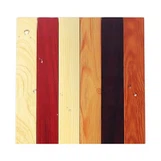Hey there! As a supplier of perforated aluminum veneer, I often get asked if it can be used in combination with other materials. The short answer is yes, and in this blog, I'll dive deep into this topic, sharing some cool insights and real - world applications.
Why Combine Perforated Aluminum Veneer with Other Materials?
First off, let's talk about why you'd want to combine perforated aluminum veneer with other materials. Perforated aluminum veneer has its own unique charm. It's lightweight, durable, and offers excellent ventilation and light - filtering properties. But sometimes, you might want to add more texture, color, or functionality to your project. That's where combining it with other materials comes in handy.
Combining with Glass
One of the most common combinations is perforated aluminum veneer with glass. Glass is known for its transparency and ability to let in natural light. When paired with perforated aluminum veneer, it creates a dynamic visual effect. The perforations in the aluminum can cast interesting shadows on the glass, adding depth and character to the facade.
For example, in modern office buildings, this combination can be used to create a sleek and contemporary look. The glass provides a clear view of the interior, while the perforated aluminum veneer adds a layer of privacy and style. It's like having the best of both worlds. You can check out more about aluminum veneer options on our Aluminum Veneer For Curtain Wall page.
Mixing with Stone
Stone is another material that pairs well with perforated aluminum veneer. Stone exudes a sense of luxury and durability. When combined with the lightweight and modern look of perforated aluminum veneer, it creates a contrast that is both striking and harmonious.
In high - end residential projects, you can use stone at the base of the building for a solid and grounded feel, and then add perforated aluminum veneer on the upper levels. The perforations can break up the mass of the stone, making the building look more airy and less imposing. This combination also works great in commercial spaces, like hotels or shopping malls, where you want to create a grand entrance.
Pairing with Wood
Wood brings a warm and natural touch to any project. Combining it with perforated aluminum veneer can result in a beautiful blend of modern and rustic elements. You can use Imitation Wood Grain Aluminum Veneer to mimic the look of real wood while still enjoying the benefits of aluminum, such as low maintenance and resistance to weather.


In outdoor spaces like restaurants or cafes, this combination can create a cozy and inviting atmosphere. The perforated aluminum veneer can be used as a partition or a screen, while the wood can be used for seating or as a decorative element. It adds a touch of nature to the otherwise modern aluminum.
Using with Plywood
Aluminum Veneer Plywood is also a great option to combine with perforated aluminum veneer. Plywood is a versatile and cost - effective material. When covered with aluminum veneer, it becomes more durable and resistant to moisture.
You can use this combination for interior wall panels. The perforated aluminum veneer can add a decorative touch, while the plywood provides a stable base. It's a practical and stylish solution for both residential and commercial interiors.
Considerations When Combining Materials
Of course, when you're combining perforated aluminum veneer with other materials, there are a few things you need to keep in mind. First, you need to consider the compatibility of the materials. Make sure they have similar expansion and contraction rates to avoid any structural issues over time.
You also need to think about the installation process. Different materials may require different installation methods, so it's important to plan ahead. Additionally, consider the maintenance requirements of each material. Some materials may need more frequent cleaning or upkeep than others.
Real - World Examples
Let's take a look at some real - world examples of projects where perforated aluminum veneer has been combined with other materials. There's a new art gallery in the city that used perforated aluminum veneer with glass on its facade. The perforations in the aluminum created ever - changing patterns of light and shadow on the glass, making the building look like a living work of art.
In a suburban housing development, a builder combined perforated aluminum veneer with stone. The stone was used at the front entrance, giving it a grand and elegant look, while the perforated aluminum veneer on the sides added a modern and contemporary touch. The result was a neighborhood of homes that stood out from the rest.
Benefits of Combining Perforated Aluminum Veneer
Combining perforated aluminum veneer with other materials offers several benefits. First, it allows you to create a unique and customized look for your project. You're not limited to just one material, so you can mix and match to achieve the exact aesthetic you want.
Second, it can improve the functionality of the building. For example, combining with glass can enhance natural light and ventilation, while pairing with stone can increase the structural integrity.
Finally, it can be a cost - effective solution. By using a combination of materials, you can balance the cost of high - end materials with more budget - friendly options without sacrificing style or quality.
Conclusion
So, can perforated aluminum veneer be used in combination with other materials? Absolutely! Whether it's glass, stone, wood, or plywood, there are endless possibilities for creating stunning and functional designs.
If you're interested in using perforated aluminum veneer or exploring combinations with other materials for your next project, I'd love to have a chat with you. Reach out to me, and we can discuss your ideas and find the perfect solutions.
References
- "Building Materials Handbook" by John Wiley & Sons
- "Modern Architectural Design Trends" magazine articles




